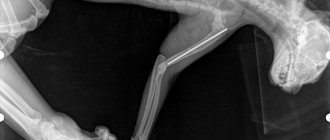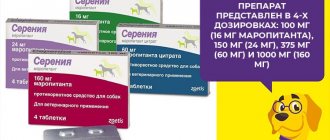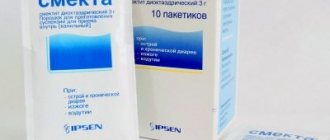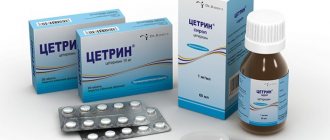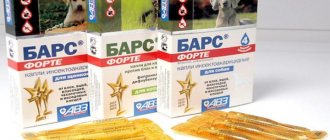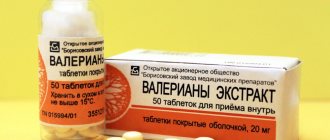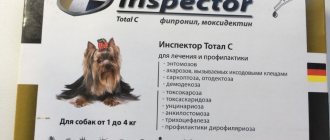What is kvamatel?
Kvamatel is an over-the-counter medicine
, which is used in small animals to reduce the amount of stomach acid produced. Although Quamatel is not FDA approved for use in veterinary medicine, veterinarians commonly prescribe this medication for small animals. Kvamatel is an H2 receptor antagonist. H2 receptor antagonists are used to reduce stomach acid production. Kvamatel promotes the healing of stomach ulcers and the formation of stomach ulcers. Kvamatel is also used to treat gastritis, esophagitis and GERD. Kvamatel may also be used for purposes other than those listed here.
Kvamatel for dogs instructions
The active ingredient of the drug, famotidine, has the ability to influence the synthesis of hydrochloric acid in the stomach. The active component blocks the functioning of histamine receptors, which, when irritated, produce hydrochloric acid. They are located on the gastric mucosa. They begin to work when food and even water enter the stomach.
The use of the drug helps prevent irritation of the gastric mucosa and excessive formation of hydrochloric acid, which can cause gastritis, ulcers and other problems with the digestive system.
The medicine also suppresses the production of pepsin, a gastric enzyme, but it has virtually no effect on the synthesis of liver enzymes.
When used correctly, Kvamatel does not affect the functioning of the liver, pancreas and spleen.
The medication is fast acting. When using tablets, the concentration of the active substance in the blood reaches its maximum value in just an hour, and with injections even faster. The drug is not completely absorbed into the bloodstream, but only 40%. The active substance is partially metabolized in the liver. The remains are excreted from the body by the kidneys.
When is it used?
Kvamatel for dogs is prescribed for the treatment of the following diseases:
- for peptic ulcer of the stomach and duodenum;
- in case of disturbances in the digestive system, accompanied by increased production of hydrochloric acid;
- with gastritis with increased stomach acidity;
- with hypersecretion of hydrochloric acid of unknown origin;
- with erosive gastroduodenitis.
The drug can also be used to prevent exacerbation of ulcers. Sometimes Kvamatel is prescribed before operations to prevent the outpouring of hydrochloric acid into the internal cavity. As an adjuvant, it can be used for severe poisoning, including those accompanied by internal bleeding.
Kvamatel for dogs is often prescribed when taking non-steroidal anti-inflammatory drugs. Medicines in this category can severely irritate the gastric mucosa. Due to irritation, the production of hydrochloric acid increases. With prolonged use, even internal bleeding may occur. An antiulcer drug helps prevent such side effects of non-steroidal drugs.
Note! It is strictly forbidden to use Kvamatel for dogs without consulting a doctor. It has contraindications and can cause serious side effects. In addition, clinical studies are necessary, since the drug can suppress the symptoms of a gastrointestinal tumor.
How to use
Since the instructions for use of Kvamatel are aimed at people, you will not find dosages and specifics of use for dogs in it.
Typically, the dosage is 0.5-1 mg of the active substance per 1 kg of weight, that is, a 10 mg tablet per 10-20 kg.
It is up to your veterinarian to determine the exact dose, as it may vary depending on your pet's weight, health, symptoms, and other factors.
For dogs, tablets with a minimum concentration of the active substance are usually used. Although when using the medicine for representatives of large breeds, you can purchase a more concentrated version of the drug.
Eating does not affect the effect of the drug, so the tablets can be mixed with food. It is advisable to give the medication in the evening, once a day.
The doctor determines the duration of treatment individually in each case.
Kvamatel injections for dogs are rarely used, especially when treated at home. The drug must be administered intravenously. To prepare the solution, you need to draw sodium chloride solution into a sterile syringe.
Pour it into the bottle with the powder through the puncture in the rubber stopper. Shake well until the solution is homogeneous, and then draw the required amount into the syringe.
The dosage is calculated in the same way as when using tablets, that is, 0.5-1 mg per 1 kg of weight. One bottle contains 20 mg of famotidine.
Note! During treatment with Kvamatel, the pet must follow a diet. You need to remove from your diet all foods that can irritate the gastric mucosa (smoked, fried, fatty, etc.). If the dog is on dry food, it needs to be switched to special medicated food.
If a check of the acidity level of gastric juice is planned, Kvamatel should be stopped one day before.
Contraindications and side effects
Kvamatel should not be used for dogs in the following cases:
- in case of intolerance to components;
- with liver failure;
- with renal failure;
- with cirrhosis of the liver.
If the animal has acute or chronic liver disease, the drug is prescribed with caution. In addition, clinical studies are periodically conducted to monitor the functioning of this organ.
The medication should not be used during pregnancy and lactation, since the active substance can penetrate into milk and through the placenta. For puppies, the medicine is also prohibited. A young, fragile body may not be able to cope with the elimination of the components of the drug, which entails developmental disorders.
Kvamatel can cause serious side effects:
- nausea and vomiting;
- diarrhea;
- disruption of the liver and pancreas;
- apathy or restlessness and aggressiveness;
- hair loss;
- itching;
- excessive sleepiness;
- weakness, lack of coordination of movements;
- muscle or joint pain;
- anaphylactic shock, etc.
The following symptoms may indicate an overdose:
- cardiopalmus;
- decreased blood pressure;
- tremor of the limbs;
- impaired motor function (the animal can rise to its paws and immediately fall).
If such symptoms are detected, you need to act immediately. The first step is to rinse the stomach to remove any remaining medication from the body. Then the dog is given enterosorbents to remove toxic components and symptomatic therapy is prescribed.
Reviews from veterinarians
Ekaterina, veterinarian with 10 years of experience:
“I often prescribe Kvamatel to my furry clients. No treatment with non-steroidal anti-inflammatory drugs is complete without this drug. It helps prevent the formation of ulcers. And although the medicine has a number of side effects, there have been no critical situations in my practice. It’s a good drug, but you need to use it on the recommendation of a doctor.”
Oleg, veterinarian with 6 years of experience:
“There are many similar diseases in animals and people, but among veterinary drugs there are sometimes no medicines for the treatment of certain pathologies.
In such situations, human medicines have to be used. For example, I have been using Kvamatel for a long time for gastritis and peptic ulcers in pets.
The drug has proven itself only from the best side. During the entire period of application there were no complaints against him.”
Many diseases of a similar nature can affect both humans and animals. When treating dogs, medications are often used that are developed for use in human therapy and have no analogues in veterinary pharmaceuticals. Such drugs include Kvamatel.
Indications for use of Kvamatela
The use of Kvamatel for dogs can be prescribed in the following cases:
- exacerbation and prevention of peptic ulcer of the duodenum and stomach; Kvamatel is prescribed for disorders of the gastrointestinal tract.
- symptomatic ulcerations of the stomach and duodenum after surgery, taking non-steroidal anti-inflammatory drugs, against the background of stress reactions;
- erosive gastroduodenitis;
- reflux esophagitis;
- indigestion due to excess acidity of gastric juice;
- Zollinger-Ellison syndrome (gastrinoma);
- prevention of the release of gastric juice during anesthesia during abdominal surgery (Mendelssohn syndrome);
- prevention of bleeding in the digestive organs (in particular, in certain types of poisoning);
- polyendocrine adenomatosis;
- dyspepsia with hypersecretion of hydrochloric acid of unknown origin.
Attention. Before using Kvamatel, the veterinarian establishes a diagnosis, takes into account the current condition of the animal and, based on this, prescribes exact doses, daily dosage, frequency of administration and course duration for each dog individually. Self-medication with the drug is unacceptable!
Instructions for use, dosage, contraindications
A single dose of the drug is from 0.5 to 1 mg per kilogram of animal weight.
Before using the drug, it is necessary to examine the dog to exclude the presence of a tumor in the stomach, because Kvamatel is able to hide the clinical picture of cancer.
Only a veterinarian can prescribe the drug Kvamatel.
Dogs are prescribed a dietary diet and any amount of fried or stale food is excluded. If the animal is fed dry industrial food, then it is transferred to specialized medicinal food.
Between taking Kvamatel and antacid drugs (Gastal, Almagel), a break of at least two hours should be maintained. Before checking the acidity of gastric juice, stop taking the drug one day.
For any liver diseases, the dosage of the drug is reduced and regular examinations are carried out. Do not prescribe a long course for weakened dogs, because In this case, gastric bacterial infections may develop. Use the medicine with caution in dogs with renal and hepatic insufficiency.
The drug is contraindicated in puppies, lactating and pregnant females.
Important. It is unacceptable to abruptly stop taking Kvamatel to avoid withdrawal syndrome. Before complete withdrawal, the dose is reduced gradually.
Reviews from dog owners
Violetta, Novosibirsk. Doctors discovered a terrible disease in our Rottweiler - lupus erythematosus. As I understand it, it is not completely cured. Now the dog is forced to constantly receive prednisolone and other medications.
Not long ago the dog started vomiting, sometimes with blood. Elsewhere, the doctor said that it was the prednisone that had caused my stomach to deteriorate. I don’t understand why they didn’t tell me to give it right away. Now Kvamatel has also been added to save the stomach. We drink and inject all medications.
Darina feels well. We'll drag it out as long as we can.
Anna, Pushkino. We found the dog on the street. This is a purebred golden retriever. The owner never showed up, so the dog remained with us. From the first day he was taken in, he vomited in the morning and walked very poorly.
We took him to the veterinarian, who said that the dog had gastritis with high acidity. He probably ate some nasty stuff while he was running alone. I was treated with Kvamatel. The medicine helped a lot.
Now he jumps like a goat and is not sick.
Dog owners praise the drug Kvamatel and say that it helped cure their pets.
Natalya Pukhova, Kirovsky village. And our Weimaraner has had stomach problems since childhood. As soon as you missed a feeding, you immediately started vomiting. This happens almost every day in the morning. And he always ate some kind of grass. A friend said that he was simply spoiled.
But we still took him to the hospital. It turned out that it was gastritis. Then my grandfather admitted that the dog stole a whole frying pan of fried meat with pepper while we were on vacation. We were also treated with Kvamatel. And they were cured, thank God. It's good that there were no consequences.
> Kvamatel for cats and dogs
veterinary aid / drugs for animals / gastroprotectors / use of quamatel in dogs and cats
Kvamatel = famotidine instructions for use
Characteristics of the substance Famotidine - quamatelWhite or pale yellow crystalline powder. Well soluble in acetic acid, slightly soluble in methanol and water, practically insoluble in ethanol. Pharmacology Pharmacological action - antiulcer.
Blocks histamine H2 receptors, inhibits basal and stimulated secretion of hydrochloric acid; suppresses the activity of pepsin. It is not completely absorbed from the gastrointestinal tract, bioavailability is 40–45%, increases under the influence of food and decreases when using antacids. Plasma protein binding is 15–20%. Cmax is reached within 1–3 hours.
30–35% is metabolized in the liver to form S-oxide and excreted by the kidneys by glomerular filtration and tubular secretion. 25–30% of the dose taken orally and 65–70% of the dose administered intravenously are found unchanged in the urine. T1/2 from plasma - 2.5–3 hours, in patients with severe renal failure (Cl creatinine 7 within 1 hour after administration.
However, at a dose of 2 mg/kg (IV every 12 hours), the effect of ranitidine on gastric pH is no different from the effect of saline solution. Thus, current recommended doses of ranitidine for dogs and cats (0.5 - 2 mg/kg every 8-12 hours) appear insufficient to have any effect.
Currently, there are no clinical studies on the effect of ranitidine on gastric diseases in dogs and cats. A typical gastroprotector of the group of H-2 histamine receptor antagonists.
Famotidine in dogs and cats
Famotidine in dogs and cats (doses in dogs and cats 0.5 mg/kg IV every 12 hours) significantly increases gastric pH in dogs compared to saline and prevents exercise-induced gastritis in Alaskan sled dogs.
It is currently the only H2 receptor blocker with some evidence of gastroprotective properties in dogs, although it is not licensed for use in animals in the UK.
The most important gastroprotector of the group of H-2 histamine receptor antagonists in dogs and cats. See antiemetics
- Gastric ulcer in dogs Gastric ulcer in dogs Gastric ulcer in dogs - Ulcus ventriculi canum - erosive inflammation...
- A breed of dog that looks like a wolf. Purebred dogs or mixed breeds? No one doubts the numerous advantages of purebred purebred dogs...
- Advocate for dogs instructionsPharmacological properties The main active ingredients of the medicine for dogs “Advocate” have a joint effect. Getting to the withers,...
- Forvet for dogs instructions 10 facts about the drug Forvet: A drug of plant origin; The drug Forvet is created on the basis of the active substance...
- How does dog castration occur? Clinical examination of a dog Since castration of a male dog is a preventive operation and does not carry any special…
Source: https://nkp-senbernar.ru/kvamatel-dlya-sobak-instruktsiya/
What are the potential side effects of Quamatel?
For small pets, if any of the following serious side effects occur, stop giving Quamatel and seek emergency veterinary medical attention; allergic reaction (difficulty breathing; swelling of the lips, tongue or face; hives). Side effects are rare but may include loss of appetite and fatigue. Other side effects may also occur. Talk to your veterinarian about any side effect that seems unusual or unpleasant to your pet.
Kvamatel for dogs: instructions for use
Pets often suffer from the same diseases as humans. In many cases, the same medications are used for treatment as for people - proven and effective. Kvamatel for dogs is used for stomach and intestinal ulcers, other acute and chronic diseases of the digestive system, which are caused by increased production of hydrochloric acid in the stomach.
Characteristic
For ulcers and hyperacidity gastritis, famotidine neutralizes hydrochloric acid and prevents irritation of the gastric mucosa.
A positive property of the substance is that it does not affect the functioning of the liver, spleen, or pancreas.
When using Kvamatel in tablets, the maximum concentration of the drug in the blood is reached within an hour, and injections begin their therapeutic effect even faster. The fact that the medicine has begun to work can be determined by the condition of the pet.
Up to 40% of the drug is absorbed into the bloodstream, the rest participates in metabolic processes occurring in the liver or is excreted by the kidneys.
Purpose
Veterinarians prescribe Kvamatel for the following digestive problems:
- peptic ulcer;
- gastritis with high acidity;
- reflux esophagitis;
- erosive gastroduodenitis and other pathologies of the gastrointestinal tract.
Kvamatel is used in complex therapy for acute poisoning, especially those accompanied by internal bleeding.
Important! Taking the medicine can hide the signs of a tumor in the gastrointestinal tract, so it is prescribed only after clinical studies.
Forms and dosage
Kvamatel is available in two dosage forms: tablets and lyophilized powder.
For injections, the powder is diluted with sodium chloride solution. The form of the medicine and the dose are prescribed by the veterinarian, but usually it is no more than 0.5-1 mg of active ingredient per 1 kg of animal body weight.
Tablets are available in different types:
For different diagnoses, dosages may vary. Kvamatel is also given before surgery to prevent aspiration of stomach contents. On the eve of the operation, the animal is given a medicine in a volume of 40 mg.
When calculating the dosage, the dog’s weight, state of health, symptoms of the disease and other factors are taken into account. The dosage must be strictly followed, since the drug has contraindications and a large list of side effects that can cause deterioration in health. Tablets can be added to food; it is recommended to give them in the evening feeding. Important! It is not recommended to give injections at home, since the medicine must be administered intravenously, strictly following the dosage.
While taking the medication, your pet will have to be put on a diet. Do not give food that can irritate the gastric mucosa. It is best to use special industrially produced medicinal food. The dosage is reduced for any problems with the liver; in this case, the doctor calculates it individually.
Discontinue the drug, gradually reducing the dose. If it is necessary to conduct a study of the acidity of gastric juice the day before the test, you must stop taking the medication.
Restrictions
The most important limitation in taking medication is age. Kvamatel cannot be prescribed to puppies under one year of age; it is not used for pregnant or lactating females. In exceptional cases, the drug is prescribed, but administration is carried out under the direct supervision of a veterinarian.
Other contraindications to taking the medication are:
- individual intolerance to components;
- renal failure;
- cirrhosis of the liver.
Caution when prescribing the drug is associated with the presence of a large number of side effects, including:
- vomit;
- intestinal upset and diarrhea;
- stomach ache;
- depressed state;
- drowsiness or, conversely, insomnia;
- restlessness, nervousness;
- decreased appetite or refusal to eat;
- alopecia.
Taking Kvamatel can cause deterioration of the liver and pancreas, arrhythmia, drop in blood pressure and bradycardia. Possible fever, itching, rash, muscle and joint pain.
Important! In case of overdose, you must immediately contact a veterinary clinic, where the dog will be vomited, the stomach will be rinsed and the necessary treatment will be prescribed.
Advantages and disadvantages
The main advantage of Kvamatel is its rapid action - it can reduce the acidity of gastric juice and normalize digestion. The drug is indispensable for the prevention and treatment of peptic ulcers and gastritis, but it has many side effects, which forces it to be used with caution.
Unfortunately, the presence of restrictions on the use of the drug forces owners of animals with hypersensitivity to look for analogues that may not be effective enough.
Analogs
There are no analogues of Kvamatel among veterinary drugs. The same active ingredient - famotidine - contains:
- Famotidine;
- Gastrotid;
- Famatel;
- Famosan et al.
You should consult your veterinarian about the possibility of using them instead of Kvamatel.
Price
The average price of medicine in tablets is 105-145 rubles. for 20 tablets, lyophilisate for preparing a solution - 370-400 rubles/20 ml.
What other drugs will affect Kvamatel?
Tell your veterinarian if your pet is given antacids, metoclopramide, sucralfate, digoxin, or ketoconazole, as this may cause an interaction. Give Quamatel 2 hours before or 2 hours after taking other medications. When taken with azathioprine, quamatel may further reduce the white blood cell count. Drugs other than those listed may also interact with quamatel. Talk to your veterinarian or pharmacist before giving any prescription or over-the-counter medications, including vitamins and supplements.
Kvamatel for dogs: indications and instructions for use, reviews, price
Kvamatel is a drug that is used for dogs for peptic ulcers and pathologies of the digestive system, accompanied by increased stomach acidity. Initially, the medicine was created for people, but it also found its use in veterinary medicine, since it has no analogues among medicines for animals.
general description
Kvamatel in pharmacies comes in the form of tablets and powder, which is used to prepare a solution for injection. The tablets are round in appearance and pink in color. The concentration of famotidine, the active substance, can be 10, 20 or 40 mg. The composition also includes auxiliary components:
- titanium dioxide;
- magnesium stearate;
- microcrystalline cellulose;
- red iron oxide;
- corn starch, etc.
Tablets are packaged in blisters of 14 pieces. There may be one or two such blisters in a cardboard package.
The white powder used to prepare the solution is packaged in glass bottles sealed with rubber stoppers. Bottles with powder are equipped with a solvent. Sodium chloride solution is used as a solvent. It is packaged in sealed glass ampoules. One cardboard package contains 5 bottles and the same number of ampoules with solvent.
How does it work?
The active ingredient of the drug, famotidine, has the ability to influence the synthesis of hydrochloric acid in the stomach. The active component blocks the functioning of histamine receptors, which, when irritated, produce hydrochloric acid. They are located on the gastric mucosa. They begin to work when food and even water enter the stomach.
The use of the drug helps prevent irritation of the gastric mucosa and excessive formation of hydrochloric acid, which can cause gastritis, ulcers and other problems with the digestive system.
The medicine also suppresses the production of pepsin, a gastric enzyme, but it has virtually no effect on the synthesis of liver enzymes.
When used correctly, Kvamatel does not affect the functioning of the liver, pancreas and spleen.
The medication is fast acting. When using tablets, the concentration of the active substance in the blood reaches its maximum value in just an hour, and with injections even faster. The drug is not completely absorbed into the bloodstream, but only 40%. The active substance is partially metabolized in the liver. The remains are excreted from the body by the kidneys.
How much does it cost and where to buy?
The price of Kvamatela varies within the following limits:
- tablets 10 mg, 14 pcs. – 65-75 rub.;
- tablets 20 mg, 28 pcs. – 125-160 rub.;
- powder + solvent, 5 doses – 400-450 rub.
The cost of the medicine is taken from online pharmacies. In regular pharmacies it may be slightly higher. You can buy the medicine at any human pharmacy.
You can now see the current price of tablets and buy them right here:
Owner reviews
Alla, mistress of the collie:
“Our dog has gastritis. Collies are highly sensitive, so many drugs are prohibited for them, but we tolerate Kvamatel well.
During periods of exacerbation of the disease, which usually pass in the spring and autumn, this remedy becomes a real salvation for us. Of course, we adjust the diet. We cook rolled oats and use special medicinal food.
Overall, I am very pleased with the effect of the drug, and it is inexpensive. The package is enough for one course.”
Anton, pit bull terrier owner:
“We were prescribed Kvamatel together with Rimadyl. The dog took painkillers due to joint problems. The doctor warned that it could cause stomach bleeding, so he additionally prescribed Kvamatel. A good and inexpensive drug. The treatment was successful. There were no side effects."
Learn about essential drugs in animals
- Vaccination of puppies
- Vaccination of cats against rabies
- Vaccination of small animals
- Vaccination for a kitten
- Why vaccinate dogs against rabies?
- Vaccinations for kittens
- Nobivac triquet trio
- Nobivak dhppi
- Puppy vaccinations
- Vaccinations for cats
- Tick vaccination for dogs
- What vaccinations for dogs?
- Ursofalk for cats
- Serenia for animals
- Ursofalk suspension for dogs, dosage
- Marfloxin for veterinary medicine
- How to use serenia in dogs
- Graying in cats
- Heptor for dogs
- Lidocaine for dogs
- Heptor for cats
- Lidocaine for cats
- Heptral for a dog
- Can cats use marfloxin?
- Marfloxin for cats - instructions
- Heptral in cats
- Dirofen suspension for cats: instructions
- Vetom 1 for cats
- multifel for cats
- Use of fosprenil in cats
^Top
